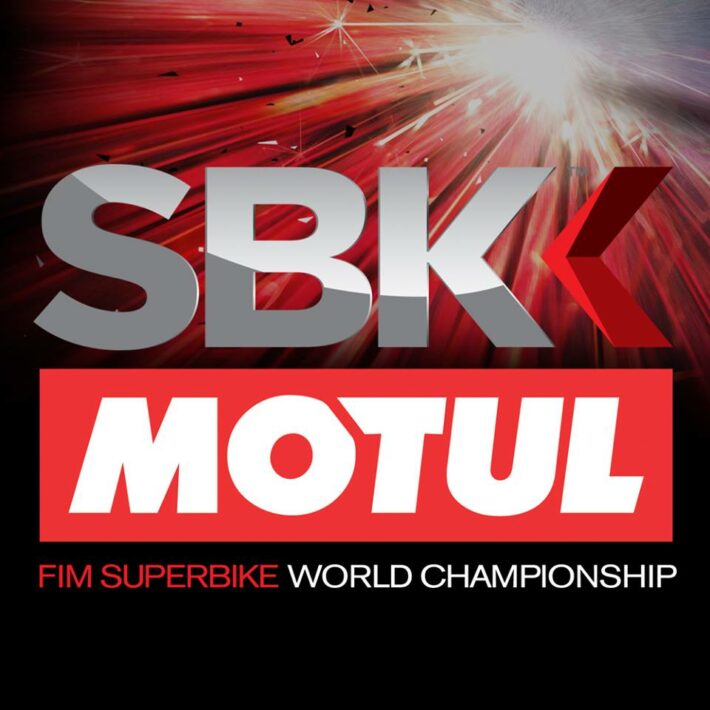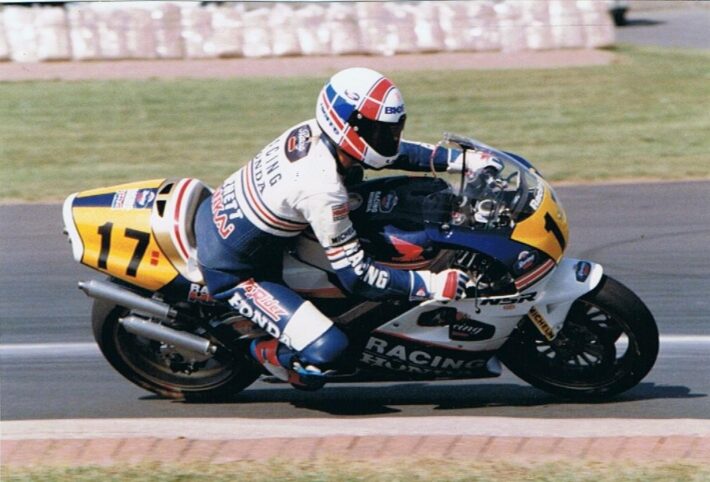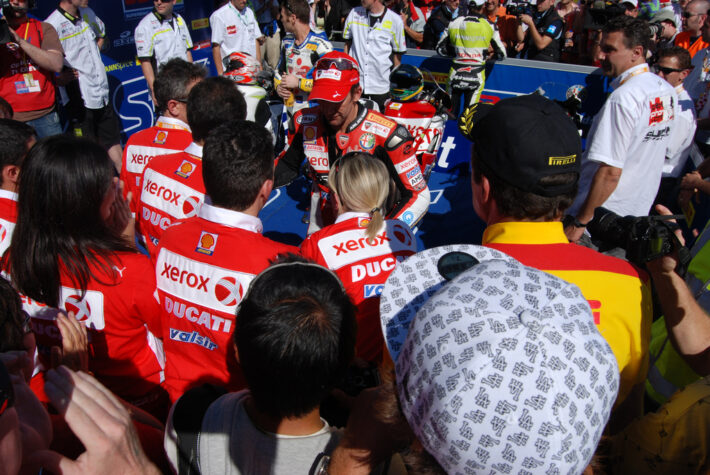History of the World Superbike Championship
The Superbike World Championship was founded in 1988 and consists of a series of 
The motorcycles that race in the championship are tuned versions of motorcycles available for sale to the public, as opposed to the purpose built, prototype machines used in MotoGP. The latter is the motorcycle world’s equivalent of Formula One with Superbikes similar to touring cars and sports car racing.
Formula One World Championship
With the Formula One World Championship already in existence, the Superbike World Championship began in 1988, with the first ever round being held at Donington Park, and so ran alongside it as a separate entity. However, it soon became clear which series was in the ascendancy and the most popular and whilst WSB immediately flourished, the F1 series was scrapped at the end of the 1990 season.
Back to the Superbikes and in 1988, the Championship was open to modified versions of road bike models available to the public. For many years, the formula allowed for machines with 1,000 cc V-twin engines (primarily Ducati but later Honda and Aprilia) to go head to head against 750cc four-cylinder engines (Honda, Yamaha, Kawasaki and Suzuki).
Roger Burnett
Roger Burnett took the first ever pole position and the first round saw two races held, as was the case up until 2019, with Davide Tardozzi of Bimota winning race 1 and thus being the first race winner in Superbikes history. Race 2 was won by Marco Lucchinelli of Ducati after Tardozzi crashed near the end of the race.
Roger Burnett at Donington Park,1989 credit Phil Wain’s Family Archives
However, for the first and only time in Superbikes history the race results were combined to determine an overall winner. Lucchinelli subsequently got the verdict, with podiums in both races and he picked up the 20 points as Fred Merkel and Joey Dunlop completed the podium.
Round Two onwards…
From round two onwards, the system was changed and points were awarded to the top 15 finishers in each leg with 10 points going to the winner and half a point going to 15th. However, this would change for the 1989 season reverting to the then traditional 20, 17, 15, 13 etc. scoring system. This then changed again in 1995 with the 25, 20, 16 etc scoring system which is still used in all major championships today.
For the first two seasons Honda won with the American Merkel and the RC30, and but the Scott Russell’s victory for Kawasaki in 1993, gradually the twins got the upper hand. Using 1,000 cc V-twin engines benefited Ducati and it was able to dominate the championship for many years, although the 750 Hondas and Kawasaki were second or third each year between 1994 and 1999.
It’s all about Foggy
Ducati won the title in 1991 and 1992 with Doug Polen, in 1994, 1995, 1998 and 1999 with Carl Fogarty and with Troy Corser in 1996. The Honda RC45 of John Kocinski was the only 750cc machine after Russell to win the Championship in 1997. Indeed, Honda eventually followed the path of Ducati and Aprilia building their own twin, the SP1, which Colin Edwards took to title glory in 2000. He repeated the win on 2002 on the next version of the machine, the SP2.
We’re taking a glimpse at Brands Hatch 1997, Foggy just secured a win during the second race…
In 2003, the FIM changed the rules to allow 1,000 cc machines (either twins, triples or four-cylinder) to race as the manufacture of 750cc machines slowly fell away. Rule changes in MotoGP to allow four-stroke meant that the Japanese manufacturers focused their resources there, leaving the Superbike World Championship with limited factory involvement. Indeed, the 2003 saw just Ducati and Suzuki have factory teams and, for the first time, the quality of the series took a major dip.
2003 also saw the entry of Carl Fogarty’s Foggy Petronas FP1, bankrolled by the Malaysian oil giant. The bike was developed under the previous regulations and was powered by a three-cylinder 900 cc engine but was ultimately fighting a losing battle. Despite having superior corner speed, it struggled on top speed and whilst it scored a number of pole positions and front rows, largely due to having an uninterrupted lap in qualifying, when confronted by other bikes during a race, it was unable to capitalise on its inherent strengths. It never won a race and only scored a handful of third place finishes.
“The Ducati Cup”
With most of the field running Ducati motorcycles, the championship received the derogatory title “the Ducati Cup”. The factory Ducati Team entered the only 2 Ducati 999’s in the field, taking 20 wins from 24 races in a season where all races were won by Ducati. Neil Hodgson won the title on a factory Ducati.
In an effort to create a more competitive field in 2004, organisers announced a series of changes to the championship. The most significant was that the teams have had to run on Pirelli control or ‘spec’ tyres. The decision to award the control tyre to Pirelli was controversial as they were considered to be below the standard of Dunlop and Michelin, the long-time dominant brands that most of the teams had been using.
Control tyre
The control tyre also meant ‘wild cards’ were unable to compete due to their own countries Championship continuing to run Dunlop and Michelin, the UK, Japan and USA being prime examples. Up until this point, the wild cards (riders who were having a one-off appearance in the Championship) had provided some stand out moments as they could compete against the regular Championship contenders and potentially win.
Nowhere was this seen more than in Japan where a whole host of local stars, more often than not on factory machinery, would flood the grid and leave the regular Championship riders scrapping for points at the lower end of the leaderboard. Hitoyasu Izutsu, Akira Ryo and Keiichi Kitagawa were some of the wild card race winners in Japan whilst Neil Hodgson, Shane Byrne and John Reynolds all achieved the feat in the UK.
Dunlop looked to take legal action against the decision while Pirelli claimed that Michelin and Dunlop were also asked if they would be interested in the one-make tyre rule contract. Partly as a result of the control tyres, the Motorcycle Sports Manufacturer Association (Aprilia, Ducati, Honda, Kawasaki, Suzuki and Yamaha) announced that no MSMA teams would participate in the Superbike World Championship, later modifying their statement allowing Ducati to participate.
Privateers in action
A few privateers chose to run Japanese bikes in 2004, particularly Ten Kate Honda who, with Chris as its rider, won races and actually contended for the title that eventually was won by James Toseland and, yet again, Ducati.
Following Ten Kate Honda’s success Japanese motorcycles made a return in 2005 with major teams from all four Japanese manufacturers run through teams ran by European importers. It was the shot in the arm the series needed and it was Troy Corser who won the 2005 championship, giving Suzuki its first Superbike World Championship title.
Over the next few years, WSB slowly got better and better and with the likes of BMW and Aprilia joining the series in 2009, the general consensus was that it was back to its best. The racing was close and up to five manufacturers were more than capable of taking the race wins as the factory teams returned in earnest.
Debate over Ducati continues
Debate continued to rage about the advantage Ducati held over the four cylinder machines particularly when their bike evolved into a machine with a capacity of 1098cc. This became 1200cc in 2008 although according to the new rules, they had to be 6 kg heavier than four-cylinder machines (168 kg to 162 kg) and would also have a 50 mm air restrictor fitted. The weight limit and the intake-restrictor size of twin machines would be updated, if needed, during the Championship, by a system analysing the race points obtained.
The popularity of Ducati remains today…
The combination of the all-new R1 Yamaha and Ben Spies finally halted Ducati’s dominance in 2009 and since then the titles have been shared between Aprilia, Ducati and Kawasaki, the latter now the dominant force in the series. Indeed, with the manufacturers re-focusing their efforts on MotoGP, the popularity of WSB has tailed off again with diminishing grids and crowds.
The championship is regulated by the FIM, the international governing body of motorcycle racing, and managed and promoted by FGSport. FGSport became part of the Infront Group in 2007 and in 2008 was rebranded as Infront Motor Sports. As of 2013 the championship is organised by Dorna, who also organise MotoGP.
Riders
Riders from all over the world compete in the Superbike World Championship and the championship is perhaps most closely followed in Italy because of Ducati’s strength in the series and in the UK where Superbike racing has been the most popular form of motorcycle racing for many years. Riders from Australia and the United States have also traditionally been successful in the world championship although there was no American present in the series between 2003 and 2007.
Take a look at this flashback to World Superbike 1994…
British rider Jonathan Rea currently has the honour of being the most successful rider in the championship’s history, winning the championship five times, and amassing a total of 88 race wins and 168 podiums. The Ulsterman overhauled Carl Fogarty’s long-standing record total of 59 wins, which all came during the 1990s, in 2018, a season that also saw him better Troy Corser’s record of 130 podiums.
Rea took his fourth title in a row in 2018, the first man to achieve the feat, which put him equal with Fogarty’s four titles which came in 1994, 1995, 1998 and 1999. However, Rea then bettered that in 2019 when he won his fifth title by 165 points despite Alvaro Bautista winning the first 11 races of the season, the first rider to achieve such a feat. Rea then made it six wins in a row in the 2020 season, shortened to eight rounds due to the COVID-19 pandemic.
Australian Troy Bayliss, who ironically replaced Fogarty at Ducati when the British rider got injured and subsequently retired in 2000, got close to his tally of four world championships with three titles and 52 wins during the 2000s.
MotoGP
Many riders successful in the Superbike World Championship have gone on to MotoGP, 
Except for Frenchman Raymond Roche in 1990, all Superbike World Champions between 1988 and 2010 were native English speakers. Since then though, Max Biaggi of Italy won the championship in 2010 and 2012, Spaniard Carlos Checa took the title in 2011 and Frenchman Sylvain Guintoli became the second Frenchman to achieve the feat in 2014.
Germany had to wait until 2008 before they first won a race, Max Neukirchner being the rider although Austrian Andreas Meklau was the first German-speaker to win a race, in 1993. Spain’s first race winner was Ruben Xaus in 2001 with Michael van der Mark taking Holland’s first in 2018 and Toprak Razgatlioglu doing the same for Turkey in 2019.
Support Classes
The Supersport World Championship has been a support class to the Superbike World Championship since 1997 when it was upgraded from European Championship status.
To be eligible for World Supersport, a motorcycle must have a four stroke engine of between 400 and 600 cc for four cylinder, 500 and 675cc for triples and between 600 and 750 cc for twins and must satisfy the FIM homologation requirements.
World Supersport regulations are much tighter than in World Superbike. The chassis of a Supersport machine must remain largely as production, while engine tuning is possible, but tightly regulated. As in world superbike a control tyre is used, although Supersport regulations dictate that the tyres must be road legal and therefore race slicks are not allowed. This changed in 2020 with slick tyres being used for the first time.
A World Supersport race takes place at every World Superbike round with the class having produced numerous riders who have gone on to compete, and win races, in the World Superbike Championship although not one rider has won world titles in both classes. Due to the shortened season, two World Supersport races were held each weekend in 2020.
FIM Superstock 1000 Cup
The FIM Superstock 1000cc and 600cc Cups were also previously held alongside the World Superbike and World Supersport races but these have now been removed with 2017 seeing the introduction of the World Supersport 300 Championship for riders with a minimum age of 15.
Spanish rider Ana Carrasco won the series in 2018 to become the first female rider in history to win a World Championship in solo motorcycle road racing.
World Superbike Milestones
1988 – Donington Park in England sees the first ever World Superbike Championship round take place on April 3rd with Italian Marco Lucchinelli taking the overall win, the only time points weren’t awarded for both legs.
1988 – American Fred Merkel clinches the inaugural title at the final round at Manfield, New Zealand.
1989 – The points system is changed to mirror that of other World Championships – 20, 17, 15, 13 etc.
1989 – Terry Rymer becomes the first Briton to win a WSB race with victory at Manfield, New Zealand.
1989 – Merkel retains his crown, again clinching it at the final round.
1990 – Raymond Roche becomes the first non-English speaking rider to win the Championship, also giving Ducati their first title.
1991 – Doug Polen becomes the second American to win the Championship with a record 17 wins.
1991 – The lead riders boycott the Canadian round at Mosport due to safety conditions.
1992 – Carl Fogarty takes his first WSB race win at Donington Park, England.
1992 – The 100th WSB race takes place at Jarama, Spain and is won by Australian Rob Phillis.
1992 – Belgium hosts a round for the first and only time with the race taking place at Spa-Francorchamps.
1993 – American Scott Russell gives Kawasaki their first rider’s championship and the only time the title was won by a 750cc across-the-frame four cylinder machine.
1994 – Carl Fogarty takes his first WSB Championship and becomes the first British rider to claim the title.
1996 – John Kocinski wins the 200th WSB race at Laguna Seca, America.
1997 – Akira Yanagawa becomes the first Japanese rider to win a race away from Sugo, Japan.
1997 – John Kocinski becomes the first rider to win both the WSB crown and one of the traditional World Championships (250cc in 1990). This is also the last time a 750cc machine wins the Championship.
1999 – Fogarty takes his fourth title which remains the most anyone has ever won.
2000 – Fogarty crashes in Australia and later announces his retirement from the sport.
2000 – Misano, Italy hosts the 300th WSB race with victory going to Australia’s Troy Corser.
2001 – Steve Hislop sets pole position at Donington Park with the fastest ever lap around the Leicestershire circuit, quicker than Valentino Rossi’s fastest ever MotoGP lap..
2002 – Colin Edwards wins the title in the final race after a year-long battle with Troy Bayliss – just nine points separate them after 26 races.
2003 – Organisers increase the capacity for four-strokes from 750cc to 1000cc but Honda, Kawasaki, Aprilia and Yamaha withdraw from the series.
2003 – The Foggy Petronas FP1 makes its series debut.
2004 – WSB organisers introduce a control tyre, Pirelli.
2004 – The UK hosts another landmark WSB race with the 400th race taking place at Silverstone. Chris Vermeulen takes the win.
2005 – Troy Corser wins his second WSB title but the first for Suzuki.
2007 – James Toseland wins his second Championship.
2008 – Troy Bayliss wins the 500th WSB race at Brno, Czech Republic.
2008 – Australian Troy Bayliss takes his third title but retires at the end of the season with a total of 52 wins, the second highest of all time.
2009 – Yamaha rejoins the series and American Ben Spies dominates the championship.
2010 – The factory BMW team join the series for the first time.
2010 – Max Biaggi becomes only the second non-English speaking rider to become world Champion and the first from Italy.
2011 – Carlos Checa becomes the first and only Spaniard to become World Superbike Champion.
2012 – Checa wins the 600th WSB race at Miller Park, USA.
2013 – Turkey hosts its first and, to date, only round.
2013 – Tom Sykes gives Kawasaki their first WSB crown since 1993.
2014 – Sylvain Guintoli gives France their second WSB title.
2015 – Jonathan Rea wins the title for Kawasaki, becoming Northern Ireland’s fourth world Champion after Ralph Bryans (50cc-1965), Joey Dunlop (Formula One – 1982-86) and Brian Reid (Formula Two – 1985-86)
2016 – The 700th WSB race is held at Aragon, Spain with victory going to Chaz Davies.
2016 – Nicky Hayden becomes the latest rider to have won races in both the 500cc/MotoGP race and World Superbike Championships.
2016 – Jonathan Rea becomes the first person since Carl Fogarty in 1999 to retain his title. Kawasaki also claim their first ever 1-2 in the Championship with Tom Sykes in second overall.
2017 – Jonathan Rea becomes the first rider in the history of WSB to win the title three years in a row. The Ulsterman also sets a new record points tally of 556, breaking Colin Edwards’ record from 2002.
2018 – Rea breaks more records, becoming the first man to win four titles in a row and also overhauling Carl Fogarty’s and Troy Corser’s long-standing records for the most wins and most podiums respectively. He also equals Doug Polen’s record from 1991 of 17 wins in a season.
2018 – Argentina hosts its first ever World Superbike race, the first in South America after the Mexican round in 1993 got cancelled after safety concerns were raised during practice.
2019 – Three races are held at each round with a full race on Saturday followed by a new ‘Sprint’ race and second full race on Sunday.
2019 – Toprak Razgatlioglu wins the 800th WSB race with victory coming at Magny Cours, France becoming the first rider from Turkey to win a WSB race in the process.
2019 – Jonathan Rea continues with his record-breaking spree as he claims his fifth consecutive world title despite Alvaro Bautista winning the first 11 races of the season, the Spaniard becoming the first rider to achieve the feat. Rea’s total points tally of 663 is another new record.
2020 – The COVID-19 pandemic limits the series to just eight rounds, the least amount ever, with a five-month gap between round one in Australia and round two in Spain. Jonathan Rea claims his sixth successive title and moves on to a career total of 99 wins with Andrea Locatelli becoming the first rider ever in the World Supersport Championship to win nine races in a row.
Next up, take a look at our World Superbike Hall of Fame!
Words by Phil Wain.

